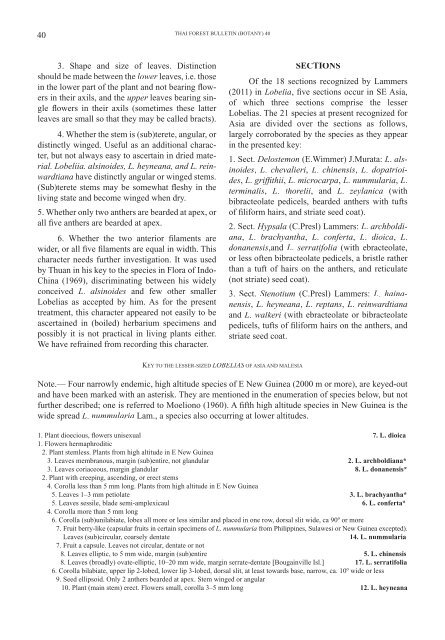Thai Forest Bulletin
Thai Forest Bulletin
Thai Forest Bulletin
Create successful ePaper yourself
Turn your PDF publications into a flip-book with our unique Google optimized e-Paper software.
40<br />
3. Shape and size of leaves. Distinction<br />
should be made between the lower r leaves, i.e. those<br />
in the lower part of the plant and not bearing fl owers<br />
in their axils, and the upper r leaves bearing sin-<br />
gle fl owers in their axils (sometimes these latter<br />
leaves are small so that they may be called bracts).<br />
4. Whether the stem is (sub)terete, angular, or<br />
distinctly winged. Useful as an additional character,<br />
but not always easy to ascertain in dried material.<br />
Lobeliia. alsinoides, L. heyneana, and L. reinwardtiana<br />
have distinctly angular or winged stems.<br />
(Sub)terete stems may be somewhat fl eshy in the<br />
living state and become winged when dry.<br />
5. Whether only two anthers are bearded at apex, or<br />
all fi ve anthers are bearded at apex.<br />
6. Whether the two anterior fi laments are<br />
wider, or all fi ve fi laments are equal in width. This<br />
character needs further investigation. It was used<br />
by Thuan in his key to the species in Flora of Indo-<br />
China (1969), discriminating between his widely<br />
conceived L. alsinoides and few other smaller<br />
Lobelias as accepted by him. As for the present<br />
treatment, this character appeared not easily to be<br />
ascertained in (boiled) herbarium specimens and<br />
possibly it is not practical in living plants either.<br />
We have refrained from recording this character.<br />
THAI FOREST BULLETIN (BOTANY) 40<br />
KEY TO THE LESSER-SIZED LOBELIASS OF ASIA AND MALESIA<br />
SECTIONS<br />
Of the 18 sections recognized by Lammers<br />
(2011) in Lobelia, fi ve sections occur in SE Asia,<br />
of which three sections comprise the lesser<br />
Lobelias. The 21 species at present recognized for<br />
Asia are divided over the sections as follows,<br />
largely corroborated by the species as they appear<br />
in the presented key:<br />
1. Sect. Delostemon (E.Wimmer) J.Murata: L. alsinoides,<br />
L. chevalieri, L. chinensis, L. dopatrioides,<br />
L. griffi thii, L. microcarpa, L. nummularia, L.<br />
terminalis, L. thorelii, and L. zeylanica (with<br />
bibracteolate pedicels, bearded anthers with tufts<br />
of fi liform hairs, and striate seed coat).<br />
2. Sect. Hypsala (C.Presl) Lammers: L. archboldiana,<br />
L. brachyantha, L. conferta, L. dioica, L.<br />
donanensis,and L. serratifolia (with ebracteolate,<br />
or less often bibracteolate pedicels, a bristle rather<br />
than a tuft of hairs on the anthers, and reticulate<br />
(not striate) seed coat).<br />
3. Sect. Stenotium (C.Presl) Lammers: L. hainanensis,<br />
L. heyneana, L. reptans, L. reinwardtiana<br />
and L. walkeri (with ebracteolate or bibracteolate<br />
pedicels, tufts of fi liform hairs on the anthers, and<br />
striate seed coat.<br />
Note.— Four narrowly endemic, high altitude species of E New Guinea (2000 m or more), are keyed-out<br />
and have been marked with an asterisk. They are mentioned in the enumeration of species below, but not<br />
further described; one is referred to Moeliono (1960). A fi fth high altitude species in New Guinea is the<br />
wide spread L. nummularia Lam., a species also occurring at lower altitudes.<br />
1. Plant dioecious, fl owers unisexual 7. L. dioica<br />
1. Flowers hermaphroditic<br />
2. Plant stemless. Plants from high altitude in E New Guinea<br />
3. Leaves membranous, margin (sub)entire, not glandular 2. L. archboldiana*<br />
3. Leaves coriaceous, margin glandular 8. L. donanensis*<br />
2. Plant with creeping, ascending, or erect stems<br />
4. Corolla less than 5 mm long. Plants from high altitude in E New Guinea<br />
5. Leaves 1–3 mm petiolate 3. L. brachyantha*<br />
5. Leaves sessile, blade semi-amplexicaul 6. L. conferta*<br />
4. Corolla more than 5 mm long<br />
6. Corolla (sub)unilabiate, lobes all more or less similar and placed in one row, dorsal slit wide, ca 90º or more<br />
7. Fruit berry-like (capsular fruits in certain specimens of L. nummularia from Philippines, Sulawesi or New Guinea excepted).<br />
Leaves (sub)circular, coarsely dentate 14. L. nummularia<br />
7. Fruit a capsule. Leaves not circular, dentate or not<br />
8. Leaves elliptic, to 5 mm wide, margin (sub)entire 5. L. chinensis<br />
8. Leaves (broadly) ovate-elliptic, 10–20 mm wide, margin serrate-dentate [Bougainville Isl.] 17. L. serratifolia<br />
6. Corolla bilabiate, upper lip 2-lobed, lower lip 3-lobed, dorsal slit, at least towards base, narrow, ca. 10º wide or less<br />
9. Seed ellipsoid. Only 2 anthers bearded at apex. Stem winged or angular<br />
10. Plant (main stem) erect. Flowers small, corolla 3–5 mm long 12. L. heyneana
















